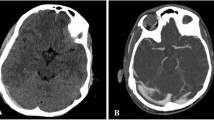Abstract
Systemic hypertension and tachycardia are often observed in the acute phase of traumatic brain injury. What causes systemic hypertension after head injury? Is systemic hypertension somehow beneficial to the injured brain? Are vasodilating drugs the first choice for treatment of systemic hypertension after traumatic brain injury? The occurrence of a hyperadrenergic state, the effects of systemic hypertension on the injured brain, the ideal blood pressure, and the management of systemic hypertension after traumatic brain injury are reviewed herein.
Similar content being viewed by others
References and Recommended Reading
Guyton AC, Hall JE: The autonomic nervous system and the adrenal medulla. In Textbook of Medical Physiology, edn 10. Philadelphia: WB Saunders; 2000:697–708.
Clifton GL, Robertson CS, Kyper K, et al.: Cardiovascular response to severe head injury. J Neurosurg 1983, 59:447–454.
Clifton GL, Ziegler MG, Grossman RG: Circulating catecholamines and sympathetic activity after head injury. Neurosurgery 1981, 8:10–14.
Wortsman J, Burns G, Van Beek AL, et al.: Hyperadrenergic state after trauma to the neuroaxis. JAMA 1980, 243:1459–1460.
Rosner MJ, Newsome HH, Becker DP: Mechanical brain injury: the sympathoadrenal response. J Neurosurg 1984, 61:76–86.
Gravenstein D, Gravenstein N: Intraoperative and immediate postoperative neuroanesthesia. In Textbook of Neurointensive Care. Edited by Layon AJ, Gabrielli A, Friedman WA. Philadelphia: WB Saunders; 2004:695–707.
Kelly DF, Doberstein C, Becker DP: General principles of head injury management. In Neurotrauma. Edited by Narayan RK, Wilberger JE, Povlishock JT. New York: McGraw-Hill; 1996:71–101.
Paulson OB, Strandgaard S, Edvinsson L: Cerebral autoregulation. Cerebrovasc Brain Metab Rev 1990, 2:161–192.
Delaney KA, Goldfrank LR: Management of the multiply injured or intoxicated patient. In Head Injury, edn 4. Edited by Cooper PR, Golfinos JG. New York: McGraw-Hill; 2000:41–62.
Schmidt EA, Czosnyka M, Steiner LA, et al.: Asymmetry of pressure autoregulation after traumatic brain injury. J Neurosurg 2003, 99:991–998. The authors observed a clear asymmetry of autoregulation between the two hemispheres after traumatic brain injury.
Simard JM, Bellefleur M: Systemic arterial hypertension in head trauma. Am J Cardiol 1989, 63:32C-35C.
Jaggi JL, Obrist WD, Gennarelli TA, et al.: Relationship of early cerebral blood flow and metabolism to outcome in acute head injury. J Neurosurg 1990, 72:176–182.
Marion DW, Darby J, Yonas H: Acute regional cerebral blood flow changes caused by severe head injuries. J Neurosurg 1991, 74:407–414.
Rosner MJ, Rosner SD, Johnson AH: Cerebral perfusion pressure: management protocol and clinical results. J Neurosurg 1995, 83:949–962.
A joint venture of The Brain Trauma Foundation, The American Association of Neurological Surgeons, The Joint Section on Neurotrauma and Critical Care: Management and prognosis of severe traumatic brain injury. J Neurotrauma 2000, 17:449–627.
Robertson CS, Valadka AB, Hannay HJ, et al.: Prevention of secondary ischemic insults after severe head injury. Crit Care Med 1999, 27:2086–2095.
Contant CF, Valadka AB, Gopinath SP, et al.: Adult respiratory distress syndrome: a complication of induced hypertension after severe head injury. J Neurosurg 2001, 95:560–568.
Juul N, Morris GF, Marshall SB, et al.: Intracranial hypertension and cerebral perfusion pressure: influence on neurological deterioration and outcome in severe head injury. The Executive Committee of the International Selfotel Trial. J Neurosurg 2000, 92:1–6. This report describes one of the three large randomized controlled trials comparing CPP-targeted therapy with ICP-targeted therapy. The authors clearly established that the critical CPP threshold is 60 mm Hg.
Guidelines for the management of severe traumatic brain injury. Update Notice: Cerebral Perfusion Pressure. http:// www2.braintrauma.org/guidelines/index.php.
Joint National Committee on Prevention, Detection, Evaluation, and Treatment of High Blood Pressure: The Sixth Report of the Joint National Committee on Prevention, Detection, Evaluation, and Treatment of High Blood Pressure. Arch Intern Med 1997, 157:2413–2446.
Sumas M, Narayan RK: Cardiopulmonary management of the head injured patient. In Neurotrauma. Edited by Narayan RK, Wilberger JE, Povlishock JT. New York: McGraw-Hill; 1996:313–329.
Hayashi M, Kobayashi H, Kawano H, et al.: Treatment of systemic hypertension and intracranial hypertension in cases of brain hemorrhage. Stroke 1988, 19:314–321.
Herregods L, Verbeke J, Rolly G, et al.: Effect of propofol on elevated intracranial pressure. Preliminary results. Anaesthesia 1988, 43(Suppl):107–109.
Eisenberg HM, Frankowski RF, Contant CF, et al.: High-dose barbiturate control of elevated intracranial pressure in patients with severe head injury. J Neurosurg 1988, 69:15–23.
Shiozaki T, Taneda M, Kishikawa M, et al.: Transient and repetitive rises in blood pressure synchronized with plasma catecholamine increases after head injury. Report of two cases. J Neurosurg 1993, 78:501–504.
Sandel ME, Abrams PL, Horn LJ: Hypertension after brain injury: case report. Arch Phys Med Rehabil 1986, 67:469–472.
Blackman JA, Patrick PD, Buck ML, et al.: Paroxysmal autonomic instability with dystonia after brain injury. Arch Neurol 2004, 61:321–328. The authors reviewed reports of autonomic dysregulation after brain injury such as TBI, hypoxia, and brain tumor. They also clarified the main features of this syndrome.
Lemke DM: Riding out the storm: sympathetic storming after traumatic brain injury. J Neurosci Nurs 2004, 36:4–9.
Author information
Authors and Affiliations
Rights and permissions
About this article
Cite this article
Shiozaki, T. Hypertension and head injury. Current Science Inc 7, 450–453 (2005). https://doi.org/10.1007/s11906-005-0040-1
Issue Date:
DOI: https://doi.org/10.1007/s11906-005-0040-1




